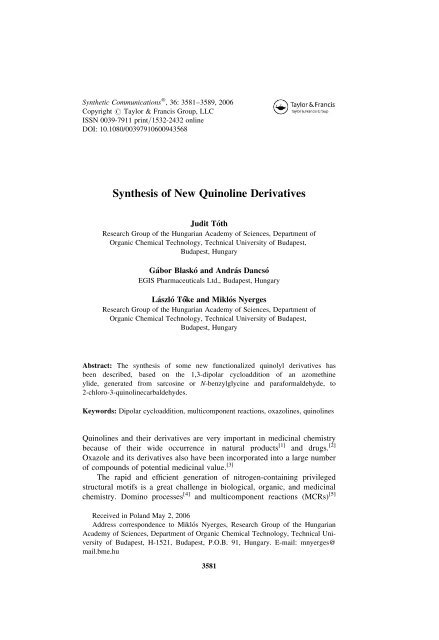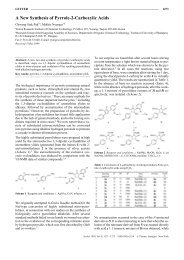Synthesis of New Quinoline Derivatives
Synthesis of New Quinoline Derivatives
Synthesis of New Quinoline Derivatives
You also want an ePaper? Increase the reach of your titles
YUMPU automatically turns print PDFs into web optimized ePapers that Google loves.
Synthetic Communications w , 36: 3581–3589, 2006<br />
Copyright # Taylor & Francis Group, LLC<br />
ISSN 0039-7911 print/1532-2432 online<br />
DOI: 10.1080/00397910600943568<br />
<strong>Synthesis</strong> <strong>of</strong> <strong>New</strong> <strong>Quinoline</strong> <strong>Derivatives</strong><br />
Judit Tóth<br />
Research Group <strong>of</strong> the Hungarian Academy <strong>of</strong> Sciences, Department <strong>of</strong><br />
Organic Chemical Technology, Technical University <strong>of</strong> Budapest,<br />
Budapest, Hungary<br />
Gábor Blaskó and András Dancsó<br />
EGIS Pharmaceuticals Ltd., Budapest, Hungary<br />
László Tó´ke and Miklós Nyerges<br />
Research Group <strong>of</strong> the Hungarian Academy <strong>of</strong> Sciences, Department <strong>of</strong><br />
Organic Chemical Technology, Technical University <strong>of</strong> Budapest,<br />
Budapest, Hungary<br />
Abstract: The synthesis <strong>of</strong> some new functionalized quinolyl derivatives has<br />
been described, based on the 1,3-dipolar cycloaddition <strong>of</strong> an azomethine<br />
ylide, generated from sarcosine or N-benzylglycine and paraformaldehyde, to<br />
2-chloro-3-quinolinecarbaldehydes.<br />
Keywords: Dipolar cycloaddition, multicomponent reactions, oxazolines, quinolines<br />
<strong>Quinoline</strong>s and their derivatives are very important in medicinal chemistry<br />
because <strong>of</strong> their wide occurrence in natural products [1] and drugs. [2]<br />
Oxazole and its derivatives also have been incorporated into a large number<br />
<strong>of</strong> compounds <strong>of</strong> potential medicinal value. [3]<br />
The rapid and efficient generation <strong>of</strong> nitrogen-containing privileged<br />
structural motifs is a great challenge in biological, organic, and medicinal<br />
chemistry. Domino processes [4] and multicomponent reactions (MCRs) [5]<br />
Received in Poland May 2, 2006<br />
Address correspondence to Miklós Nyerges, Research Group <strong>of</strong> the Hungarian<br />
Academy <strong>of</strong> Sciences, Department <strong>of</strong> Organic Chemical Technology, Technical University<br />
<strong>of</strong> Budapest, H-1521, Budapest, P.O.B. 91, Hungary. E-mail: mnyerges@<br />
mail.bme.hu<br />
3581
3582<br />
J. Tóth et al.<br />
<strong>of</strong>fer excellent avenues to face these challenges. As a part <strong>of</strong> our research<br />
program aimed at synthesizing nitrogen-containing druglike heterocyles by<br />
the combined use <strong>of</strong> domino and multicomponent reactions, we became<br />
interested in the oxazolidine-coupled quinoline molecules 3.<br />
RESULTS AND DISCUSSION<br />
The starting quinolines (2a–d) for the MCR were prepared by the method<br />
described by O. Meth-Cohn from the corresponding acetanilides by the<br />
treatment with the Vilsmeier reagent in a very effective domino reaction. [6]<br />
Recently we have described the three-component reaction <strong>of</strong> aromatic<br />
aldehydes, sarcosine, and paraformaldehyde, with a view to preparing<br />
3-methyl-5-aryl-oxazolidines, which were valuable intermediates for<br />
further elaboration to 2-dimethylamino-1-phenylethanols. [7] This process<br />
utilizes a 1,3-dipolar cycloaddition reaction, which generally affords a<br />
simple and convenient method for the regio- and stereoselective construction<br />
<strong>of</strong> a variety <strong>of</strong> complex pyrrolidine derivatives. However, the azomethine<br />
ylides can react with C 5O double bonds in 1,3-dipolar cycloadditions, and<br />
several oxazolidine-type cycloadducts have been described, but in these<br />
cases either (a) the aldehyde component <strong>of</strong> the azomethine ylide, formed in<br />
situ, was the same as the dipolarophile, [8] or (b) a stable precursor <strong>of</strong> the<br />
azomethine ylide was prepared in advance and this was followed by the<br />
cycloaddition step. [8a,9]<br />
Based on these results, we synthesized with our MCR a variety <strong>of</strong> 5-(3-<br />
quinolyl)-oxazilidine 3 by simple mixing <strong>of</strong> sarcosine or N-benzylglycine,<br />
paraformaldehyde, and a 2-chloro-3-formyl-quinoline (as the dipolarophile)<br />
in toluene and refluxing under Dean–Stark conditions (Scheme 1). In all<br />
cases only the formaldehyde served as a component for the nonstabilized azomethine<br />
ylide generation, and the cycloadduct 3a–h was isolated in good<br />
yield as the sole product (Table 1).<br />
The heterocyclic ring structure <strong>of</strong> products 3a–e was confirmed by IR, 1 H<br />
NMR, and 13 C NMR spectral studies. The 1 H NMR and H-HCOSY spectra <strong>of</strong><br />
3c reveal two sharp singlets at d 2.53 and 3.92 due to the OCH 3 <strong>of</strong> the<br />
Scheme 1.
<strong>Synthesis</strong> <strong>of</strong> <strong>New</strong> <strong>Quinoline</strong> <strong>Derivatives</strong> 3583<br />
Table 1. 1,3-Dipolar addition reaction <strong>of</strong> 2-chloro-3-formyl-quinolines (2a–e) and<br />
azomethine ylide generated from paraformaldehyde and sarcosine<br />
Entry R 1 R 2 R 3 Starting material Product Yield (%)<br />
1 H H H 2a 3a 92<br />
2 H H Ph 2a 3b 84<br />
3 H MeO H 2b 3c 87<br />
4 H MeO Ph 2b 3d 65<br />
5 Cl Me H 2c 3e 95<br />
6 Cl Me Ph 2c 3f 80<br />
7 Me H H 2d 3g 91<br />
8 Me H Ph 2d 3h 78<br />
quinoline and N-methyl oxazolidine protons. Both <strong>of</strong> the N–CH 2 proton <strong>of</strong><br />
H-4 appeared as a doublet <strong>of</strong> a doublet at d 3.62 and 2.85 (J ¼ 6.7 and<br />
11.3 Hz). The H-5 proton exhibited as triplet at d 5.35 with J ¼ 6.5 Hz.<br />
Two doublets appeared in the region d 4.66–4.53 (J ¼ 5.1 Hz) for H-2<br />
protons.<br />
The aromatic protons <strong>of</strong> the quinoline ring appeared as in the region <strong>of</strong> d<br />
8.26–7.29 with the expected pattern. The 13 C NMR spectra <strong>of</strong> 3c exhibited<br />
peaks at d 89.3, 73.6, and 61.4 ppm for the oxazolidine ring carbons. The<br />
peaks at d 55.5 ppm and at d 41.7 ppm are due to the oxazolidine N-methyl<br />
and methoxy carbons <strong>of</strong> the quinoline ring respectively.<br />
In conclusion, we have developed a new, two-step route by the combined<br />
use <strong>of</strong> domino and multicomponent reactions from simple starting materials<br />
for the synthesis <strong>of</strong> a 3-quinolyl-1,3-oxazolone ring system via the 1,3-<br />
dipolar cycloaddition reaction <strong>of</strong> nonstabilized azomethine ylides to<br />
aldehydes. This oxazolidines could be valuable building blocks <strong>of</strong> other<br />
compunds <strong>of</strong> general interest. [10]<br />
EXPERIMENTAL<br />
General<br />
Column chromatography was performed using Merck Kieselgel 60 70–230<br />
mesh and thin-layer chromatography (TLC) on aluminium sheets coated<br />
with Kieselgel 60 F 254 . Plates were stained with anisaldehyde solution<br />
(100 ml glacial acetic acid, 2 ml <strong>of</strong> concn. sulphuric acid, and 1 ml <strong>of</strong> anisaldehyde)<br />
and heated at ca. 1508C. Phosphoryl chloride (Aldrich) and N,Ndimethylformamide,<br />
anhydrous (Aldrich) were used as received. All<br />
solvents were purified according to standard procedures. IR spectra were<br />
obtained on a Bruker Vector 22 FT-IR instrument. NMR spectra were
3584<br />
J. Tóth et al.<br />
obtained on Varian Inova 500 and Bruker DRX-500. Chemical shifts are given<br />
relative to d TMS .<br />
General Procedure for the <strong>Synthesis</strong> <strong>of</strong> 2-Chloro-3-<br />
quinolinecarbaldehydes (2a–d)<br />
These compounds were prepared by the method <strong>of</strong> Meth-Cohn et al. [6]<br />
N,N-Dimethylformamide (9.1 g, 9.6 ml, 0.125 mol) was cooled to 08C, and<br />
phosphoryl chloride (53.7 g, 32.2 ml, 0.35 mol) was added dropwise with<br />
stirring. To this solution was added the corresponding acetanilide<br />
(0.05 mol), and the temperature <strong>of</strong> the reaction mixture was raised to 808C<br />
for 18 h. The cooled reaction mixture was poured into ice water (300 ml)<br />
and stirred for 1 h at 0–108C. The precipitated 2-chloro-3-quinolinecarbaldehyde<br />
was failtered <strong>of</strong>f, washed with water (100 ml), dried, and recrystallized<br />
from ethyl acetate to give the title product.<br />
Data<br />
2-Chloro-3-quinolinecarbaldehyde (2a): pale yellow powder (5.92 g, 62%),<br />
mp 146–1478C (lit. [6b] 148–1498C); 1 H NMR (500 MHz, CDCl 3 ): 10.51<br />
(s, 1H, CHO), 8.81 (s, 1H, H-4), 8.09 (d, 1H, J ¼ 8.2 Hz, H-5), 8.03 (d, 1H,<br />
J ¼8.2 Hz, H-8), 7.92 (t, 1H, J ¼ 8.2 Hz, H-6), 7.69 (t, 1H, J ¼ 8.2 Hz,<br />
H-7); HRMS (E.I) [M] þ calcd. for C 10 H 6 C1NO ¼ 191.01379; found<br />
191.0147.<br />
2-Chloro-6-methoxy-3-quinolinecarbaldehyde (2b): pale yellow powder<br />
(5.41 g, 49%), mp 143–1448C (lit. [6b] 145.5–146.58C);<br />
1 H NMR<br />
(500 MHz, CDCl 3 ): 10.50 (s, 1H, CHO), 8.57 (s, 1H, H-4), 7.91 (d, 1H,<br />
J ¼ 9.0 Hz, H-8); 7.46 (dd, 1H, J ¼ 9.0 Hz and 2.8 Hz, H-7), 7.17 (d, 1H,<br />
J ¼ 2.8 Hz, H-5), 3.94 (s, 3H, OCH 3 ); HRMS (E.I) [M] þ calcd. for<br />
C 11 H 8 C1NO 2 ¼ 221.02436; found 221.0261.<br />
2,6-Dichloro-8-methyl-3-quinolinecarbaldehyde (2c): pale yellow powder<br />
(4.68 g, 39%), mp 146–1488C; 1 H NMR (500 MHz, CDCl 3 ): 10.55 (s, 1H,<br />
CHO), 8.61 (s, 1H, H-4), 7.78 (s, 1H, H-5), 7.67 (s, 1H, H-7), 2.77 (s, 3H,<br />
Me); 13 C NMR (125 MHz, CDCl 3 ): 189.1 (q), 149.2 (q), 147.2 (q), 139.3<br />
(CH), 139.2 (q), 134.1 (CH), 133.5 (q), 127.2 (q), 126.8 (q), 125.8 (CH),<br />
17.7 (CH 3 ); IR (KBr, cm 21 ): 3050, 1693, 1628, 1582, 1379, 1038. HRMS<br />
(E.I) [M] þ calcd. for C 11 H 7 C1 2 NO ¼ 238.99047; found 238.9911.<br />
2-Chloro-8-methyl-3-quinolinecarbaldehyde (2d): pale yellow powder<br />
(7.40 g, 72%), mp 1388C (lit. [6b] 137–1388C);<br />
1 H NMR (500 MHz,<br />
CDCl 3 ): 10.52 (s, 1H, CHO), 8.64 (s, 1H, H-4), 7.76 (d, 1H, J ¼ 8.2 Hz,
<strong>Synthesis</strong> <strong>of</strong> <strong>New</strong> <strong>Quinoline</strong> <strong>Derivatives</strong> 3585<br />
H-5), 7.68 (d, 1H, J ¼ 8.2 Hz, H-7), 7.50 (t, 1H, J ¼ 8.2 Hz, H-6), 2.75 (s, 3H,<br />
CH 3 ); HRMS (E.I) [M] þ calcd. for C 11 H 8 C1NO ¼ 205.02944; found<br />
205.0301.<br />
General Procedure for the Cycloaddition Reaction <strong>of</strong> Azomethine<br />
Ylide Generated from Paraformaldehyde and Sarcosine<br />
or N-Benzyl Glycine with 2-Chloro-3-formyl-quinolines (2a–d)<br />
The corresponding 2-chloro-3-formyl-quinoline (1 mmol), sarcosine or<br />
N-benzyl-glycine (2 mmol), and paraformaldehyde (5 mmol), were<br />
suspended in toluene (50 ml), and the reaction mixture was then heated for<br />
10 h under Dean–Stark conditions. After the reaction was complete, it was<br />
filtered through a pad <strong>of</strong> Celite, the solvent was removed in vacuo, and the<br />
residue was purified by flash chromatography (acetone/hexane 1:3).<br />
Data<br />
5-(2-Chloro-3-quinolyl)-3-methyl-1,3-oxazolone (3a): pale yellow oil.<br />
NMR (500 MHz, CDCl 3 ): 8.40 (s, 1H, qui-H-4), 7.97 (d, 1H, J ¼ 8.2 Hz,<br />
qui-H-5), 7.68 (d, 1H, J ¼ 8.2 Hz, qui-H-8), 7.55 (t, 1H, J ¼ 8.2 Hz, qui-<br />
H-6), 7.50 (t, 1H, J ¼ 8.2 Hz, qui-H-7), 5.35 (t, 1H, J ¼ 6.9 Hz, H-5), 4.65<br />
(d, 1H, J ¼ 5.0 Hz, H-2), 4.52 (d, 1H, J ¼ 5.0 Hz, H-2), 3.61 (dd, 1H,<br />
J ¼ 6.9 and 11.1 Hz, H-4), 2.85 (dd, 1H, J ¼ 6.9 and 11.1 Hz, H-4), 2.51<br />
(s, 3H, NCH 3 ); 13 C NMR (125 MHz, CDCl 3 ): 148.0 (q), 146.6 (q), 146.65<br />
(q), 134.4 (CH), 129.9 (CH), 127.9 (CH), 127.4 (CH), 127.1 (q), 126.9 (CH),<br />
89.2 (CH 2 ), 73.4 (CH), 61.2 (CH 2 ), 41.4 (CH 3 ); IR (neat, cm 21 ): 3061, 2951,<br />
2870, 2800, 1676, 1619, 1592, 1565, 1492, 1455, 1398, 1326, 1158, 1055,<br />
1029; HRMS (E.I) [M] þ calcd. for C 13 H 13 C1 N 2 O ¼ 248.07164; found<br />
248.0739.<br />
5-(2-Chloro-3-quinolyl)-3-benzyl-1,3-oxazolone (3b): pale yellow oil. 1 H<br />
NMR (500 MHz, CDCl 3 ): 8.36 (s, 1H, qui-H-4), 7.99 (d, 1H, J ¼ 7.8 Hz,<br />
qui-H-5), 7.81 (d, 1H, J ¼ 7.8 Hz, qui-H-8), 7.67 (t, 1H, J ¼ 7.8 Hz, qui-H-<br />
6), 7.52 (t, 1H, J ¼ 7.8 Hz, qui-H-7), 7.34–7.24 (m, 5H, Ph), 5.35 (t, 1H,<br />
J ¼ 7.0 Hz, H-5), 4.67 (d, 1H, J ¼ 5.5 Hz, H-2), 4.63 (d, 1H, J ¼ 5.5 Hz,<br />
H-2), 3.81 (s, 2H, NCH 2 ), 3.74 (dd, 1H, J ¼ 7.0 and 11.7 Hz, H-4), 2.86<br />
(dd, 1H, J ¼ 7.0 and 11.7 Hz, H-4); 13 C NMR (125 MHz, CDCl 3 ): 148.1<br />
(q), 146.7 (q), 138.2 (q), 134.4 (q), 134.3 (q), 129.9 (CH), 128.5 (2 CH),<br />
128.3 (2 CH), 128.0 (CH), 127.5 (CH), 127.3 (CH), 127.2 (CH),<br />
127.0 (CH), 87.2 (CH 2 ), 73.4 (CH), 59.2 (CH 2 ), 58.3 (CH 2 ). IR (neat,<br />
cm 21 ): 3062, 2927, 2876, 1676, 1592, 1565, 1493, 1454, 1398, 1326, 1076,<br />
927; HRMS (E.I) [M] þ calcd. for C 19 H 17 C1 N 2 O ¼ 324.10294; found<br />
324.1001.<br />
1 H
3586<br />
J. Tóth et al.<br />
5-(6-Methoxy-2-chloro-3-quinolyl)-3-methyl-1,3-oxazolone (3c): pale<br />
yellow oil. 1 H NMR (500 MHz, CDCl 3 ): 8.26 (s, 1H, qui-H-4), 7.89 (d, 1H,<br />
J ¼ 9.2 Hz, qui-H-8), 7.35 (dd, 1H, J ¼ 2.8 and 9.2 Hz, qui-H-7), 7.09<br />
(d, 1H, J ¼ 2.8 Hz, qui-H-5), 5.35 (t, 1H, J ¼ 6.5 Hz, H-5), 4.66 (d, 1H,<br />
J ¼ 5.1 Hz, H-2), 4.53 (d, 1H, J ¼ 5.1 Hz, H-2), 3.92 (s, 3H, OCH 3 ), 3.62<br />
(dd, 1H, J ¼ 6.7 and 11.3 Hz, H-4), 2.85 (dd, 1H, J ¼ 6.7 and 11.3 Hz,<br />
H-4), 2.53 (s, 3H, NCH 3 ); 13 C NMR (125 MHz, CDCl 3 ): 158.2 (CH), 145.5<br />
(q), 142.8 (q), 134.7 (CH), 133.3 (q), 129.5 (CH), 128.4 (q), 122.7 (CH),<br />
105.2 (CH), 89.3 (CH 2 ), 73.6 (CH), 61.4 (CH 2 ), 55.5 (CH 3 ), 41.7 (CH 3 );<br />
IR (neat, cm 21 ): 2955, 2870, 2801, 1671, 1623, 1592, 1498, 1455,<br />
1329, 1228, 1165, 1123, 1056, 1032, 959; HRMS (E.I) [M] þ calcd. for<br />
C 14 H 15 C1 N 2 O 2 ¼ 278.08220; found 278.0852.<br />
5-(6-Methoxy-2-chloro-3-quinolyl)-3-benzyl-1,3-oxazolone (3d): pale yellow<br />
oil. 1 H NMR (500 MHz, CDCl 3 ): 8.25 (s, 1H, qui-H-4), 7.86 (d, 1H, J ¼ 9.2 Hz,<br />
qui-H-8), 7.33–7.25 (m, 6H, Ph and qui-H-7), 7.06 (d, 1H, J ¼ 2.8 Hz, qui-H-<br />
5), 5.33 (t, 1H, J ¼ 6.8 Hz, H-5), 4.66 (d, 1H, J ¼ 5.5 Hz, H-2), 3.87 (s, 3H,<br />
OCH 3 ), 3.81 (s, 2H, NCH 2 ), 3.72 (dd, 1H, J ¼ 6.8 and 11.8 Hz, H-4), 3.57<br />
(dd, 1H, J ¼ 6.8 and 11.8 Hz, H-4); 13 C NMR (125 MHz, CDCl 3 ): 158.0 (q),<br />
145.4 (q), 142.6 (q), 138.2 (q), 134.5 (q), 133.1 (CH), 129.3 (CH), 128.5<br />
(2 CH), 128.3 (2 CH), 128.2 (q), 127.2 (CH), 122.5 (CH), 105.0 (CH),<br />
87.1 (CH 2 ), 73.3 (CH), 59.2 (CH 2 ), 58.2 (CH 2 ), 55.3 (CH 3 ). IR (neat, cm 21 ):<br />
3062, 2935, 2878, 1674, 1594, 1498, 1454, 1329, 1061, 998; HRMS (E.I)<br />
[M] þ calcd. for C 20 H 19 C1 N 2 O 2 ¼ 354.11350; found 354.1147.<br />
5-(2,8-Dichloro-6-methyl-3-quinolyl)-3-methyl-1,3-oxazolone (3e): pale<br />
yellow oil. 1 H NMR (500 MHz, CDCl 3 ): 8.23 (s, 1H, qui-H-4), 7.65 (d, 1H,<br />
J ¼ 2.1 Hz, qui-H-5), 7.49 (d, 1H, J ¼ 2.1 Hz, qui-H-7), 5.35 (t, 1H,<br />
J ¼ 6.5 Hz, H-5), 4.65 (d, 1H, J ¼ 5.1 Hz, H-2), 4.53 (d, 1H, J ¼ 5.1 Hz,<br />
H-2), 3.56 (dd, 1H, J ¼ 6.5 and 11.5 Hz, H-4), 2.84 (dd, 1H, J ¼ 6.5 and<br />
11.5 Hz, H-4), 2.73 (s, 3H, CH 3 ), 2.52 (s, 3H, CH 3 ); 13 C NMR (125 MHz,<br />
CDCl 3 ): 147.4 (q), 144.6 (q), 138.6 (q), 135.5 (q), 133.8 (CH), 132.4 (q),<br />
130.8 (CH), 128.0 (q), 124.0 (CH), 89.4 (CH 2 ), 73.5 (CH), 61.3 (CH 2 ), 41.6<br />
(CH 3 ), 17.6 (CH 3 ); IR (KBR, cm 21 ): 3694, 2963, 2794, 1654, 1522, 1322,<br />
1263, 1099, 1022; HRMS (E.I) [M] þ calcd. for C 14 H 14 C1 2 N 2 O ¼ 296.04831;<br />
found 296.0499.<br />
5-(2,8-Dichloro-6-methyl-3-quinolyl)-3-benzyl-1,3-oxazolone (3f): pale<br />
yellow oil. 1 H NMR (500 MHz, CDCl 3 ): 8.24 (s, 1H, qui-H-4), 7.65 (s, 1H,<br />
qui-H-5), 7.49 (s, 1H, qui-H-7), 7.36–7.25 (m, 5H, Ph), 5.35 (t, 1H,<br />
J ¼ 7.0 Hz, H-5), 4.67 (d, 1H, J ¼ 5.6 Hz, H-2), 4.63 (d, 1H, J ¼ 5.6 Hz,<br />
H-2), 3.83 (s, 2H, NCH 2 ), 3.76 (dd, 1H, J ¼ 7.0 and 11.8 Hz, H-4), 3.73<br />
(dd, 1H, J ¼ 7.0 and 11.8 Hz, H-4), 2.72 (s, 3H, CH 3 );<br />
13 C NMR<br />
(125 MHz, CDCl 3 ): 147.4 (q), 144.6 (q), 138.6 (q), 138.3 (q), 135.4 (q),<br />
133.8 (CH), 132.4 (q), 130.8 (CH), 128.7 (2 CH), 128.5 (2 CH), 127.9
<strong>Synthesis</strong> <strong>of</strong> <strong>New</strong> <strong>Quinoline</strong> <strong>Derivatives</strong> 3587<br />
(q), 127.4 (CH), 124.1 (CH), 87.4 (CH 2 ), 73.4 (CH), 59.3 (CH 2 ), 58.4 (CH 2 ),<br />
17.6 (CH 3 ); IR (neat, cm 21 ): 3063, 2925, 2876, 1701, 1592, 1479, 1454, 1327,<br />
1053, 997; HRMS (E.I) [M] þ calcd. for C 20 H 18 C1 2 N 2 O ¼ 372.07961; found<br />
372.0811.<br />
5-(8-Methyl-2-chloro-3-quinolyl)-3-methyl-1,3-oxazolone (3g): pale yellow<br />
oil.<br />
1 H NMR (500 MHz, CDCl 3 ): 8.31 (s, 1H, qui-H-4), 7.65 (d, 1H,<br />
J ¼ 8.1 Hz, qui-H-5), 7.52 (d, 1H, J ¼ 8.1 Hz, qui-H-7), 7.42 (t, 1H, J ¼<br />
8.1 Hz, qui-H-6), 5.36 (t, 1H, J ¼ 6.7 Hz, H-5), 4.65 (d, 1H, J ¼ 5.0 Hz,<br />
H-2), 4.53 (d, 1H, J ¼ 5.1 Hz, H-2), 3.63 (dd, 1H, J ¼ 6.7 and 11.5 Hz,<br />
H-4), 2.85 (dd, 1H, J ¼ 6.7 and 11.5 Hz, H-4), 2.75 (s, 3H, CH 3 ), 2.53<br />
(s, 3H, NCH 3 ); 13 C NMR (125 MHz, CDCl 3 ): 147.1 (q), 146.1 (q), 136.2<br />
(CH), 134.6 (q), 134.1 (q), 130.0 (CH), 127.3 (CH), 126.7 (q), 125.5 (CH),<br />
89.3 (CH 2 ), 73.5 (CH), 61.4 (CH 2 ), 41.6 (CH 3 ), 17.7 (CH 3 ); IR (neat,<br />
cm 21 ): 3010, 2952, 2860, 2806, 1653, 1599, 1576, 1485,1463, 1395, 1377,<br />
1363, 1323, 1206, 1170, 1122, 1088, 1060, 1044, 1009; HRMS (E.I)<br />
[M] þ calcd. for C 14 H 15 C1 N 2 O ¼ 262.08729; found 262.0879.<br />
5-(8-Methyl-2-chloro-3-quinolyl)-3-benzyl-1,3-oxazolone (3h): pale yellow<br />
oil.<br />
1 H NMR (500 MHz, CDCl 3 ): 8.32 (s, 1H, qui-H-4), 7.66 (d, 1H,<br />
J ¼ 7.2 Hz, qui-H-5), 7.51 (d, 1H, J ¼ 7.2 Hz, qui-H-7), 7.42 (t, 1H,<br />
J ¼ 7.2 Hz, qui-H-6), 7.34–7.22 (m, 5H, Ph), 5.36 (t, 1H, J ¼ 6.7 Hz, H-5),<br />
4.67 (d, 1H, J ¼ 5.5 Hz, H-2), 4.63 (d, 1H, J ¼ 5.5 Hz, H-2), 3.82 (s, 2H,<br />
NCH 2 ), 3.74 (dd, 1H, J ¼ 7.2 and 11.8 Hz, H-4), 2.86 (dd, 1H, J ¼ 7.2 and<br />
11.8 Hz, H-4), 2.74 (s, 3H, CH 3 ); 13 C NMR (125 MHz, CDCl 3 ): 147.1 (q),<br />
146.1 (q), 138.3 (q), 136.3 (q), 134.6 (CH), 134.1 (q), 130.1 (CH), 128.6<br />
(2 CH), 128.4 (2 CH), 128.4 (q), 127.3 (CH), 126.8 (CH), 125.5 (CH),<br />
87.3 (CH 2 ), 73.5 (CH), 59.4 (CH 2 ), 58.4 (CH 2 ), 19.0 (CH 3 ); IR (neat,<br />
cm 21 ): 3062, 2876, 1641, 1597, 1495, 1454, 1326, 1075, 905; HRMS (E.I)<br />
[M] þ calcd. for C 20 H 19 C1 N 2 O ¼ 338.11859; found 338.1197.<br />
ACKNOWLEDGMENTS<br />
This work was financially supported by the National Fund for Science and<br />
Research, Hungary (OTKA Project No. T 046196). N. M. thanks the<br />
Hungarian Academy <strong>of</strong> Sciences for a Bolyai J. Fellowship. A grant from<br />
the József Varga Foundation provided to J. T. is gratefully appreciated.<br />
REFERENCES<br />
1. (a) Michael, J. P. <strong>Quinoline</strong>, quinazoline and acridone alkaloids. Nat. Prod. Rep.<br />
2004, 650–668; (b) Michael, J. P. <strong>Quinoline</strong>, quinazoline and acridone<br />
alkaloids. Nat. Prod. Rep. 2003, 476–493.
3588<br />
J. Tóth et al.<br />
2. (a) Alhaider, A. A.; Abdelkader, M. A.; Lien, E. J. Design, synthesis and<br />
pharmacological activities <strong>of</strong> 2-substituted 4-phenylquinolines as potential antidepressant<br />
drugs. J. Med. Chem. 1985, 28, 1394–1398; (b) Campbell, S. F.;<br />
Hardstone, J. D.; Palmer, M. J. 2,4-Diamino-6,7-dimethoxyquinoline derivatives<br />
as a 1 -adrenoceptor antagonists and antihypertensive agents. J. Med. Chem.<br />
1988, 31, 1031–1035; (c) Wu, D. Towards new anticancer drugs: A decade <strong>of</strong><br />
advances in synthesis <strong>of</strong> camptothecins and related alkaloids. Tetrahedron 2003,<br />
59, 8649–8687.<br />
3. Konosu, T.; Tajima, Z.; Takeda, N.; Miyaoka, T.; Kashara, M.; Yasuda, H.;<br />
Oida, S. Triazole antifungals 2. <strong>Synthesis</strong> and antifungal activities <strong>of</strong> 3-acyl-4-<br />
methyloxazolidine derivatives. Chem. Pharm. Bull. 1990, 38, 2476–2486.<br />
4. (a) Tietze, L. F. Domino reactions in organic synthesis. Chem. Rev. 1996, 96,<br />
115–136; (b) Helene Pellissier asymmetric domino reactions. part A: Reactions<br />
based on the use <strong>of</strong> chiral auxiliaries. Tetrahedron 2006, 62, 1619–1665.<br />
5. (a) Kappe, C. O. Recent advances in the biginelli dihydropyrimidine synthesis:<br />
<strong>New</strong> tricks from an old dog. Acc. Chem. Res. 2000, 33, 879–888;<br />
(b) Domling, A. Recent developments in isocyanide based multicomponent<br />
reactions in applied chemistry. Chem. Rev. 2006, 106, 17–89;<br />
(c) Muthusamy, S.; Gunanathan, C.; Nethaji, M. Multicomponent reactions <strong>of</strong> diazoamides:<br />
Diastereoselective synthesis <strong>of</strong> mono- and bis-spir<strong>of</strong>urooxindoles.<br />
J. Org. Chem. 2004, 69, 5631–5637; (d) Basso, A.; Banfi, L.; Riva, R.;<br />
Guanti, G. A novel highly selective chiral auxiliary for the asymmetric synthesis<br />
<strong>of</strong> L- and D-a-amino acid derivatives via a multicomponent ugi reaction. J. Org.<br />
Chem. 2005, 70, 575–579.<br />
6. (a) Meth-Cohn, O.; Narine, B. Versatile new synthesis <strong>of</strong> quinolines, thienopyridines<br />
and related fused pyridines. Tetrahedron Lett. 1978, 19, 2045–2048;<br />
(b) Meth-Cohn, O.; Narine, B.; Tarnowski, B. A versatile new synthesis <strong>of</strong> quinolines,<br />
thienopyridines and related fused pyridines 5: The synthesis <strong>of</strong> 2-chloroquinoline-3-carbaldehydes.<br />
J. Chem. Soc., Perkin Trans. 1 1981, 1520–1530.<br />
7. (a) Rudas, M.; Fejes, I.; Nyerges, M.; Szölló´sy, Á.; Tó´ke, L.; Groundwater, P. W.<br />
Substituent effects on 4p þ 2p cycloadditions to some 4H-pyran-4-one derivatives.<br />
J. Chem. Soc. Perkin Trans 1. 1999, 1167–1172; (b) Nyerges, M.;<br />
Fejes, I.; Virányi, A.; Groundwater, P. W.; Tó´ke, L. A new convenient synthesis<br />
<strong>of</strong> 2-dimethylamino-1-arylethanols. <strong>Synthesis</strong> 2001, 1479–1482.<br />
8. (a) Tsuge, O.; Kanemasa, S.; Ohe, M.; Takenaka, S. Simple generation <strong>of</strong> nonstabilized<br />
azomethine ylides through decarboxylative condensation <strong>of</strong> a-amino acids<br />
with carbonyl compounds via 5-oxazilidone intermediates. Bull. Chem. Soc. Jpn.<br />
1987, 60, 4079–4089; (b) Ardill, H.; Grigg, R.; Sridharan, V.; Surendrakumar, S.;<br />
Thianpatanagul, S.; Kanajun, S. Iminium ion route to azomethine ylides from<br />
primary and secondary amines. J. Chem. Soc. Chem. Commun. 1986, 602–603;<br />
(c) Orsini, F.; Pellizzoni, F.; Forte, M.; Destro, R.; Gariboldi, P. 1,3-Dipolar cycloadditions<br />
<strong>of</strong> azomethine ylides with aromatic aldehydes synthesis <strong>of</strong> 1-oxapyrrolizidines<br />
and 1,3-oxazolidines. Tetrahedron 1988, 44, 519–541; (d) Rizzi, G. R.<br />
Evidence for an azomethine ylide intermediate in the carbonyl-assisted decarboxylation<br />
<strong>of</strong> sarcosine: Novel synthesis <strong>of</strong> dl-phenylephrine hydrochloride. J. Org. Chem.<br />
1970, 35, 2069–2072.<br />
9. Tsuge, O.; Hatta, T.; Tashiro, H.; Kakura, Y.; Maeda, H.; Kakehi, H. Tetrahedron<br />
2000, 56, 7723–7735.<br />
10. (a) Gosselin, F.; Roy, A.; O’Shea, P. D.; Chen, C.-Y.; Volante, R. P.<br />
Oxazolidine ring opening and isomerization to (E)-imines: Asymmetric<br />
synthesis <strong>of</strong> aryl-a-fluoroalkyl amino alcohols. Org. Lett. 2004, 6, 641–644;
<strong>Synthesis</strong> <strong>of</strong> <strong>New</strong> <strong>Quinoline</strong> <strong>Derivatives</strong> 3589<br />
(b) Vasse, J.-L.; Joosten, A.; Denhez, C.; Szymoniak, J. Stereoselective<br />
synthesis <strong>of</strong> pyrrolidines from N-allyl oxazolidines via hydrozirconation-cyclization.<br />
Org. Lett. 2005, 7, 4887–4889; (c) Conde-Frieboes, K.; Schjeltved, R. K.;<br />
Breinholt, J. Diastereoselective synthesis <strong>of</strong> 2-aminoalkyl-3-sulfonyl-1,3-oxazolidines<br />
on solid support. J. Org. Chem. 2002, 67, 8952–8957; (d) Blanchet, J.;<br />
Bonin, M.; Micouin, L.; Husson, H.-P. <strong>Synthesis</strong> <strong>of</strong> enantiomerically pure<br />
a-substituted propargylic amines by reaction <strong>of</strong> organoaluminum reagents<br />
with oxazolidines. J. Org. Chem. 2000, 65, 6423–6426; (e) Iwata, A.;<br />
Tang, H.; Kunai, A.; Ohshita, J.; Yamamoto, Y.; Matui, C. Ring-opening<br />
reactions <strong>of</strong> cyclic acetals and 1,3-oxazolidines with halosilane equivalents.<br />
J. Org. Chem. 2002, 67, 5170–5175; (f) Marcotte, S.; Pannecoucke, X.;<br />
Feasson, C.; Quirion, J.-C. Enantioselective synthesis <strong>of</strong> a,a-difluoro-b-amino<br />
acid and 3,3-difluoroazetidin-2-one via the reformatsky-type reaction <strong>of</strong> ethyl<br />
bromodifluoroacetate with chiral 1,3-oxazolidines. J. Org. Chem. 1999, 64,<br />
8461–8464.


